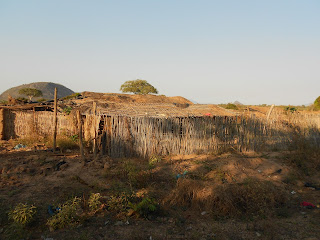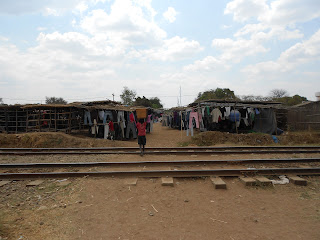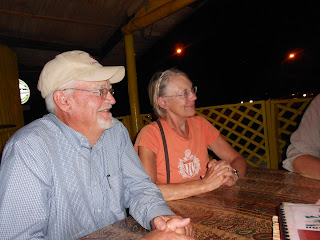I am going to make some comments in summary of my trip to Mozambique in September. I know it seems a bit late but there are some observations to make since my trip. We have posted some pictures.
Most of the pictures were taken during the 12 hour train ride from Nampula to Cuamba. The ride started in the dark at 5 am on 11 September. So, I missed the entire drama of the 11 Sept Benghazi situation. I was in that time zone, interestingly enough. There was very little coverage available to me. From first to last of the pictures, I will provide some general information. The terrain is referred to as "bush". It is a gently rolling plain, with "mountains" popping up in the backround all the way along. The colors were beautiful.
Housing: I estimate 80% of the homes were bamboo walls and straw roofs. No electricity in most cases. People came down to the train at each of 15-20 stops during the 12 hour train ride. At each stop, local people brought local produce to the train "stations" to sell to passengers. Many of the pics are of the activity at the stops. There were two classes of travel on the train, 2nd and 3rd class. 2nd was made up compartments that held 6 people. The seats could be converted to beds and overhead compartments. Traveling was pleasant. No animosity noted.
Eating on train. I called it the "club" car. In fact it was a basic kitchen with seating for about 20. I had chicken and rice. It was tasty. Purpose of the train ride was to get me to my assingment at Cuamba, a village of about 5000 people in northwest central Mozambique. The alternative was a car or truck ride over dirt roads. There is a paved road going in but not completed. One of the pictures shows construction in progress. In some of the pictures, you will note some paths going away from the railroad. These lead back into small farms and houses. Children unattended would run right up to the railroad barefoot. The train certainly seemed to be the highlight of the day. You will notice a lot of tower like structures. These are water towers. Water is a problem. "Normally" the rainy season starts in about December and ends in March-April. This is also the planting season. Harvest will occur in late spring and early summer by our calender(March-July, depending on the crop). I was in Mozambique in September which was the heart of the dry season. A few days before I arrived, the faculty housing in which I stayed had run out of water.
Referring to faculty housing---my volunteer assignment was the Faculty of Agriculture at a Catholic University in the village of Cuamba. There were about 300 students. The charge was to develop a low cost soyfood production line(actually a processing line for soybeans), but one of the restrictions was that it be low cost. Extrusion processsing for animal feed involves equipment and a high energy usage, so we opted for soy for human consumption. This had the dual advantage of meeting the requirement of adding value at a low cost and offering a way to increase protein in the local diet.
FARMS and FARMING: The University(FAC) has a 700 acre farm, of which about100 acres was being used for row crops. The rotation was white maize, soybeans, and pigeon peas(an indigenous crop with an intermediate protein level). Traditionally the area has not grown soybeans. The local export grain company did not handle soybeans. The farms are subsistence. And if there is no rain, the last 3 months of the year will result in a rationing not via price, but via eating less of whatever the peasants have grown. Both pigeon peas and white maize are part of thelocal diet. The University had about 10 tonnes of soybeans in storage from previous years. It is all non Genetically Modified(Non GMO). This could be sold for about 20 meticales per kg to a poultry processor about 250 miles away, used for seed for next years production, and/or made into soyfood(at this stage only a small portion will be soyfoods). Since the soy production(soja locally) is non GM it has no licensing restrictions and can be used for seed. New seed costs 50 meticales per kg. The value of the soy for market is only 20 meticales per kg, so it makes sense to use the production(at least a portion of the production) for seed. After I had left, the local peasants and the University(FAC) were discussing a plan whereby FAC would "loan" seed to local farmers for their production and the farmers would pay back the FAC at harvest at the rate of 2 units of production for one unit of seed.
The above barter points up what I believe is the biggest need for Mozambique agriculture: credit---there is not viable banking system. The government, though supposedly a republic is largely influenced by monied interests. That is not all bad if the money goes to the local economy. In this case however, the money circulates to the government from the outside interests to perpetuate corruption in government. The bankings system is not agressive but passive. One of the reasons for this is the fact of some past history of load default. There obviously is a disconnect here. The west and now China, Japan, Brazil has thrown money at this country and others for decades to the point that a culture of "neediness" is prevalent. The program that I was a part of, CNFA, funded by the farm bill, was to have worked to establish enterprise and independence in the areas that it has worked. It was not to be just another charity program. That is the goal, at least.
Subsequent to my visit, the FAC has participated in promotion of soyfood consumption via agricultural fairs.
Mozambique is a former Portuguese colony. Most of the countries surrounding it were British colonies(Republic of S Africa, Zimbabwe(southern Rhodesia),Zambia(northern Rhodesia)Malawi, Tanzania etc. Portuguese is the official language and as such it has a natural affinity to Brazil. South America is the source of most of the soy imports, due to an increasing SAm production and a favorable geographic affinity with SAm.
Mozambique has a growing poultry industry. The soy for poultry feed is 80% imported. Mozambique produces only 20%. So, soy production is a natural. Land is not fully utilized and it really seems as though the peasants can increase production by just plowing a few more hectares of land. But they must purchase inputs. How, with no cash and no credit.(actually they can borrow money at 20-30% which they think is fairly reasonable, but perhaps not economic)
What might work?-----Of the neighboring countries, South Africa and Zimbabwe have a developed commercial agriculture. There is a resistance to foreign investment, as foreign investment would be viewed as losing control. However, production coops have been formed whereby, inputs are supplied by larger commercial interests(production interests as well as agri business). Likewise the production will be marketed back to the larger producers. This provides credit, reasonable input costs, and an uptick in the value of the surplus production. This will require some private capital, some forward thinking peasant/farmers willing to enterprise themselves, and some government oversight. The government and communities will need to enforce some sort of legal commercial system so committments are honored.
The alternative: Continued peasantry and dependence. bad diets in years of food shortages.
OTHER: There is an amazing amount of activity from the west in one sort or another in Africa. One of the anecdotal items that I came across was as follows: As I was leaving Beira(on the Indian ocean) to fly to Johanesburg and then home, I met a gent in the airport from Mt Vernon IL. Imagine that. He had been in Mozambique for a week to train and set up 2 railroad locomotives that a company in Mt Vernon had sold to the government of Mozambique. Unique guy. Was Mexican born, but has lived lately in the US and also knew Portuguese. A unique set of talents for a highly specialized job.
The big railroad excitement in MZ now is the movement of coal from the inland state of Tete to the Indian ocean ports of Beira and Ncala.
This is probably the end of my blog on MZ. Sorry for delay but did not want to let it go.
Jim






















































